Preface
This book is intended to be used as a text for either undergraduate level
(junior/senior) courses in probability or introductory graduate level courses in
random processes that are commonly found in Electrical Engineering curricula.
While the subject matter is primarily mathematical, it is presented for engineers.
Mathematics is much like a well-crafted hammer. We can hang the tool on our wall
and step back and admire the fine craftmanship used to construct the hammer, or
we can pick it up and use it to pound a nail into the wall. Likewise, mathematics
can be viewed as an art form or a tool. We can marvel at the elegance and rigor, or
we can use it to solve problems. It is for this latter purpose that the mathematics is
presented in this book. Instructors will note that there is no discussion of algebras,
Borel fields, or measure theory in this text. It is our belief that the vast majority of
engineering problems regarding probability and random processes do not require
this level of rigor. Rather, we focus on providing the student with the tools and
skills needed to solve problems. Throughout the text we have gone to great effort
to strike a balance between readability and sophistication. While the book provides
enough depth to equip students with the necessary tools to study modern commu-
nication systems, control systems, signal processing techniques, and many other
applications, concepts are explained in a clear and simple manner that makes the
text accessible as well.
It has been our experience that most engineering students need to see how the
mathematics they are learning relates to engineering practice. Toward that end, we
have included numerous engineering application sections throughout the text to
help the instructor tie the probability theory to engineering practice. Many of these
application sections focus on various aspects of telecommunications since this com-
munity is one of the major users of probability theory, but there are applications to
xi
�
xii
Preface
other fields as well. We feel that this aspect of the text can be very useful for accred-
itation purposes for many institutions. The Accreditation Board for Engineering
and Technology (ABET) has stated that all electrical engineering programs should
provide their graduates with a knowledge of probability and statistics including
applications to electrical engineering. This text provides not only the probability
theory, but also the applications to electrical engineering and a modest amount of
statistics as applied to engineering.
A key feature of this text, not found in most texts on probability and random
processes, is an entire chapter devoted to simulation techniques. With the advent of
powerful, low-cost, computational facilities, simulations have become an integral
part of both academic and industrial research and development. Yet, many stu-
dents have major misconceptions about how to run simulations. Armed with the
material presented in our chapter on simulation, we believe students can perform
simulations with confidence.
It is assumed that the readers of this text have a background consistent with
typical junior level electrical engineering curricula. In particular, the reader should
have a knowledge of differential and integral calculus, differential equations, lin-
ear algebra, complex variables, discrete math (set theory), linear time-invariant
systems, and Fourier transform theory. In addition, there are a few sections in
the text that require the reader to have a background in analytic function the-
ory (e.g., parts of Section 4.10), but these sections can be skipped without loss
of continuity. While some appendices have been provided with a review of
some of these topics, these presentations are intended to provide a refresher for
those who need to “brush up” and are not meant to be a substitute for a good
course.
For undergraduate courses in probability and random variables, we recommend
instructors cover the following sections:
Chapters 1–3: all sections,
Chapter 4: sections 1–6,
Chapter 5: sections 1–7 and 9,
Chapter 6: sections 1–3,
Chapter 7: sections 1–5.
These sections, along with selected application sections, could easily be covered in
a one semester course with a comfortable pace. For those using this text in grad-
uate courses in random processes, we recommend that instructors briefly review
Chapters 1–7 focussing on those concepts not typically taught in an undergraduate
course (e.g., Sections 4.7–4.10, 5.8, 5.10, 6.4, and 7.6) and then cover selected topics
of interest from Chapters 8–12.
�
Preface
xiii
We consider the contents of this text to be appropriate background material
for such follow-on courses as Digital Communications, Information Theory, Cod-
ing Theory, Image Processing, Speech Analysis, Synthesis and Recognition, and
similar courses that are commonly found in many undergraduate and graduate
programs in Electrical Engineering. Where possible, we have included engineering
application examples from some of these topics.
�
Introduction 1
The study of probability, random variables, and random processes is fundamental
to a wide range of disciplines. For example, many concepts of basic probability
can be motivated through the study of games of chance. Indeed, the foundations
of probability theory were originally built by a mathematical study of games of
chance. Today, a huge gambling industry is built on a foundation of probability.
Casinos have carefully designed games that allow players to win just enough
to keep them hooked, while keeping the odds balanced slightly in favor of the
“house.” By nature, the outcomes of these games are random, but the casino owners
fully understand that as long as the players keep playing, the theory of probabil-
ity guarantees—with very high probability—that the casino will always come out
ahead. Likewise, those playing the games may be able to increase their chances of
winning by understanding and using probability.
In another application of probability theory, stock investors spend a great deal
of time and effort trying to predict the random fluctuations in the market. Day
traders try to take advantage of the random fluctuations that occur on a daily basis,
whereas long-term investors try to benefit from the gradual trends that unfold over
a much longer time period. These trends and fluctuations are random in nature and
hence can be described only in a probabilistic fashion. Another business built on
managing random occurrences is the insurance industry. Insurance premiums are
calculated based on a careful study of the probabilities of various events happening.
For example, the car insurance salesman has carefully evaluated the inherent risk
of various classes of drivers and will adjust the premiums of each class according to
the probabilities that those drivers will have an accident. In yet another application,
a meteorologist tries to predict future weather events based on current and past
meteorological conditions. Since these events are random, the weather forecast will
often be presented in terms of probabilities (e.g., there is a 40 percent chance, or
probability, of rain on Tuesday).
1
�
2
Chapter 1 Introduction
Since the theory of probability and random processes finds such a wide range
of applications, students require various levels of understanding depending on the
particular field they are preparing to enter. For those who wish to improve their
proficiency at card games, a firm understanding of discrete probability may be
sufficient. Those going into operations management need to understand queueing
theory and therefore Markov and related random processes. A telecommunications
engineer needs to have a firm understanding of models of noise and the design of
systems to minimize the effects of noise.
This book is not intended to serve the needs of all disciplines, but rather
is focused on preparing students entering the fields of electrical and computer
engineering. One of the main goals of the text is to prepare the student to
study random signals and systems. This material is fundamental to the study
of digital signal processing (voice,
image, video, etc.), communications sys-
tems and networks, radar systems, power systems, and many other applications
within the engineering community. With this readership in mind, a background
consistent with most electrical and computer engineering curricula is assumed.
That is, in addition to fundamental mathematics including calculus, differen-
tial equations, linear algebra, and complex variables, the student is assumed to
be familiar with the study of deterministic signals and systems. We understand
that some readers may be very strong in these areas, while others may need
to “brush up.” Accordingly, we have included a few appendices that may help
those who need a refresher and also provide a quick reference for significant
results.
Throughout the text, the reader will find many examples and exercises that
utilize MATLAB. MATLAB is a registered trademark of the MathWorks, Inc.;
it is a technical software computing environment. Our purpose for introducing
computer-based examples and problems is to expand our capabilities so that
we may solve problems too tedious or complex to do via hand calculations.
Furthermore, MATLAB has nice plotting capabilities that can greatly assist the
visualization of data. MATLAB is used extensively in practice throughout the
engineering community; therefore, we feel it is useful for engineering students
to gain exposure to this important software package. Examples in the text that use
MATLAB are clearly marked with a small computer logo.
Before diving into the theory of discrete probability in the next chapter, we first
provide a few illustrations of how the theory of probability and random processes
is used in several engineering applications. At the end of each subsequent chapter,
the reader will find engineering application sections that illustrate how the material
presented in that chapter is used in the real world. These sections can be skipped
without losing any continuity, but we recommend that the reader at least skim
through the material.
�
1.1 A Speech Recognition System
3
1.1 A Speech Recognition System
Many researchers are working on methods for computer recognition of speech.
One application is to recognize commands spoken to a computer. Such systems
are presently available from several vendors. A simple speech recognition sys-
tem might use a procedure called template matching, which may be described
as follows. We define a vocabulary, or a set of possible words for a computer-
ized dictionary. This restricts the number of possible alternatives that must be
recognized. Then a template for each word is obtained by digitizing the word as it
is spoken. A simple dictionary of such templates is shown in Figure 1.1. The tem-
plate may be the time waveform, the spectrum of the word, or a vector of selected
features of the word. Common features might include the envelope of the time
waveform, the energy, the number of zero crossings within a specified interval,
and the like.
Speech recognition is a complicated task. Factors that make this task so difficult
include interference from the surroundings, variability in the amplitude and dura-
tion of the spoken word, changes in other characteristics of the spoken word such
as the speaker’s pitch, and the size of the dictionary to name a few. In Figure 1.2,
we have illustrated some of the variability that may occur when various speakers
say the same word. Here we see that the waveform templates may vary consider-
ably from speaker to speaker. This variability may be described by the theory of
probability and random processes, which in turn may be used to develop models
for speech production and recognition. Such models may then be used to design
systems for speech recognition.
Vocabulary
Template
hello
yes
no
bye
Figure 1.1 A simple dictionary of speech templates for speech recognition.
�
4
Chapter 1 Introduction
Templates
Speaker 1
(male)
Speaker 2
(male)
Speaker 3
(female)
Speaker 4
(child)
Vocabulary
hello
yes
no
bye
Figure 1.2 Variations in speech templates for different speakers.
1.2 A Radar System
A classical problem drawing heavily on the theory of probability and random
processes is that of signal detection and estimation. One example of such a problem
is a simple radar system, such as might be used at an airport to track local air traffic.
A known signal is converted to an electromagnetic wave and propagated via an
antenna. This wave will reflect off an aircraft and return back to the antenna, where
the signal is processed to gather information about the aircraft. In addition to being
corrupted by a random noise and interference process, the returning signal itself
may exhibit randomness. First, we must determine if there is a reflected signal
present. Usually, we attempt to maximize the probability of correctly detecting an
aircraft subject to a certain level of false alarms. Once we decide that the aircraft
is there, we attempt to estimate various random parameters of the reflected signal
to obtain information about the aircraft. From the time of arrival of the reflected
signal, we can estimate the distance of the aircraft from the radar site. The fre-
quency of the returned signal will indicate the speed of the aircraft. Since the
desired signal is corrupted by noise and interference, we can never estimate these
various parameters exactly. Given sufficiently accurate models for these random
�
1.3 A Communication Network
5
Figure 1.3 A radar system.
disturbances, however, we can devise procedures for providing the most accurate
estimates possible. We can also use the theory of probability and random processes
to analyze the performance of our system.
1.3 A Communication Network
Consider a node in a computer communication network, such as that depicted in
Figure 1.4, that receives packets of information from various sources and must
forward them along toward their ultimate destinations. Typically, the node has a
Figure 1.4 Nodes and links in a communications network.
�

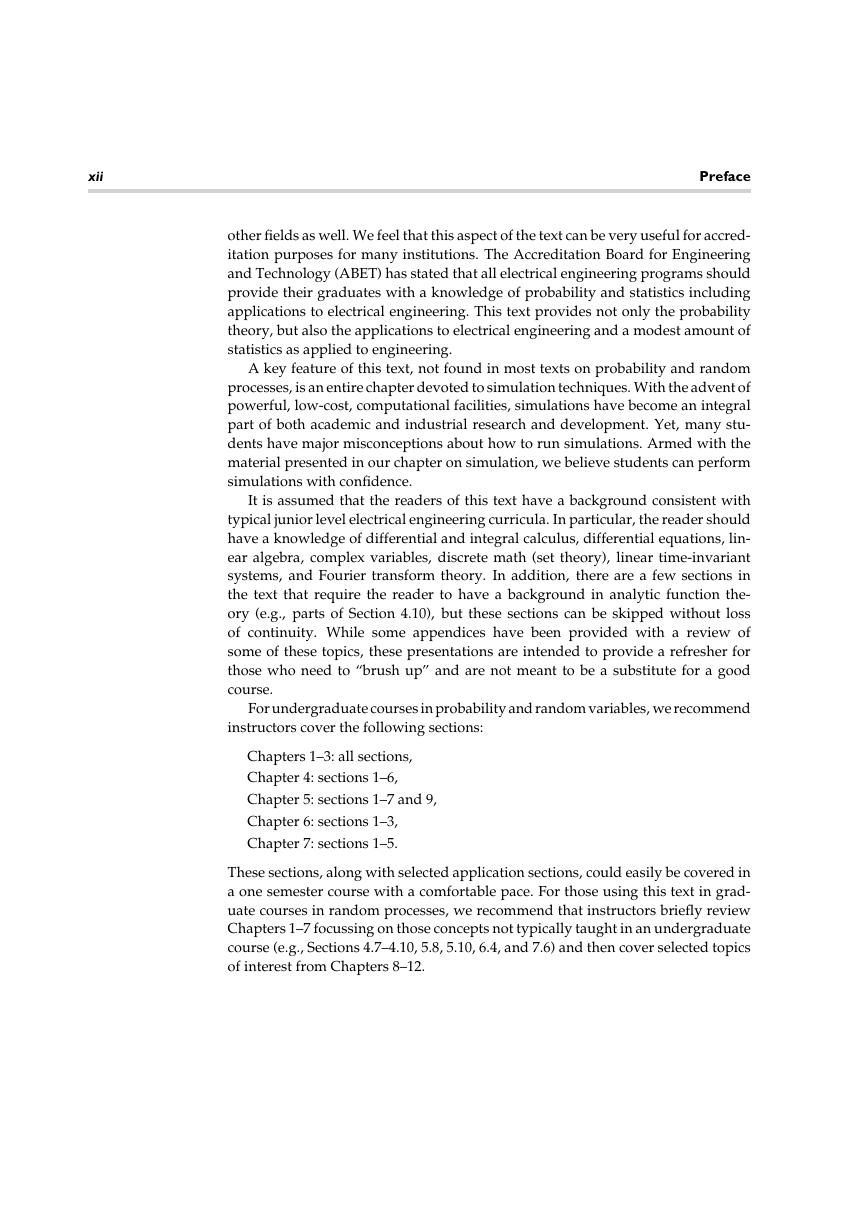

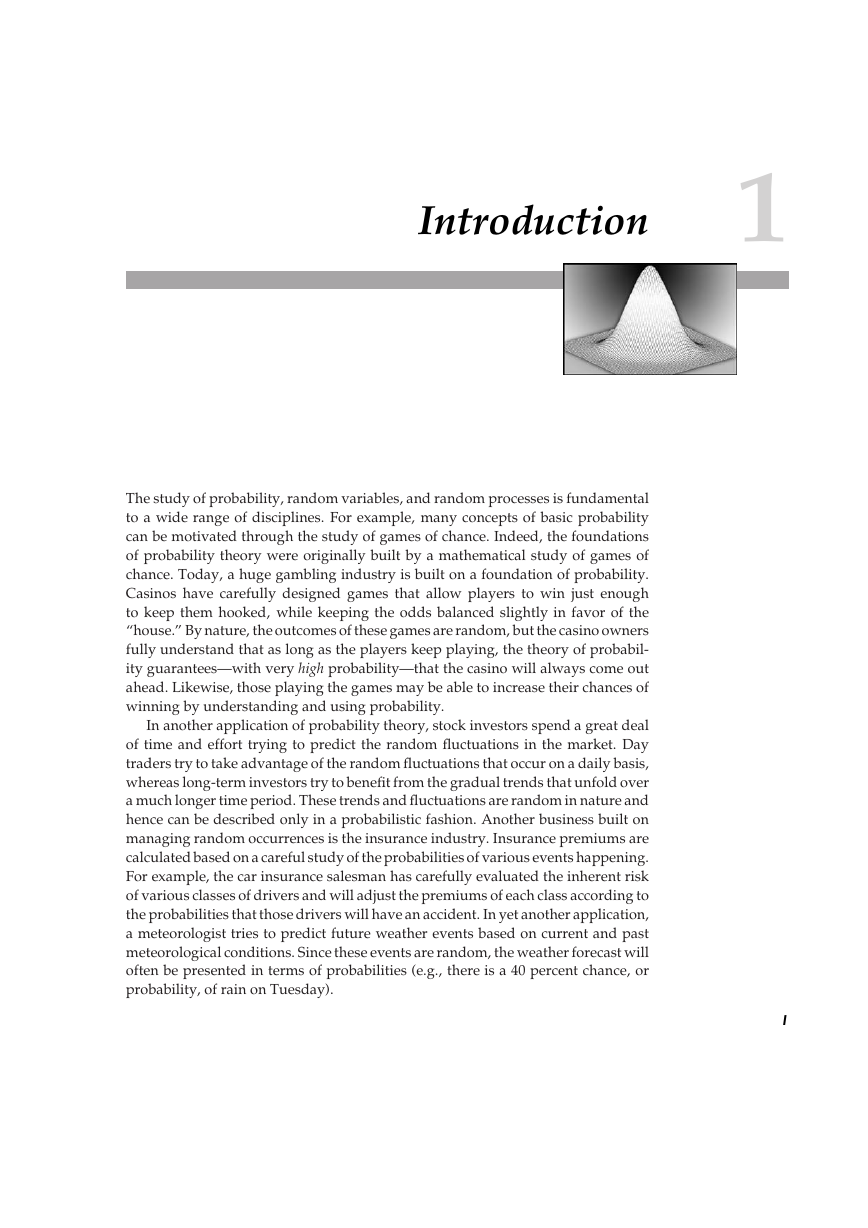

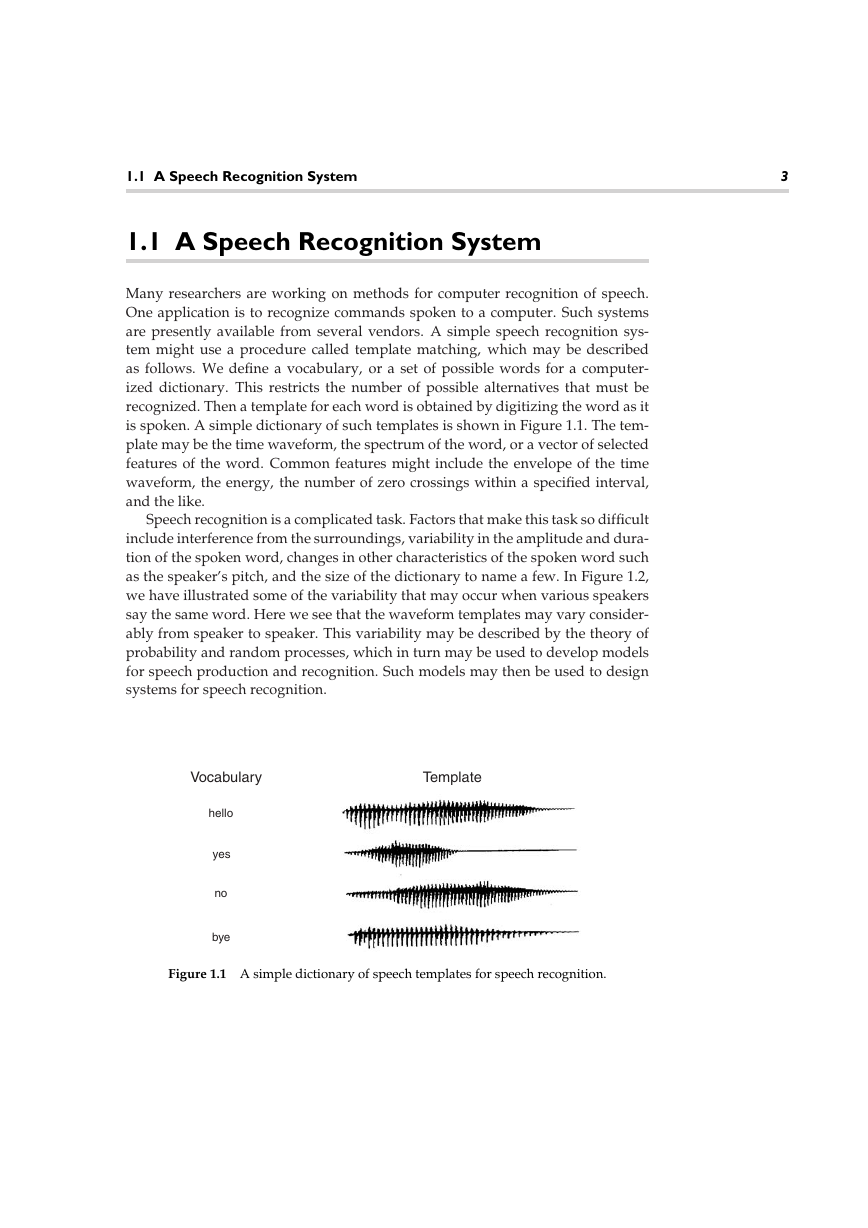
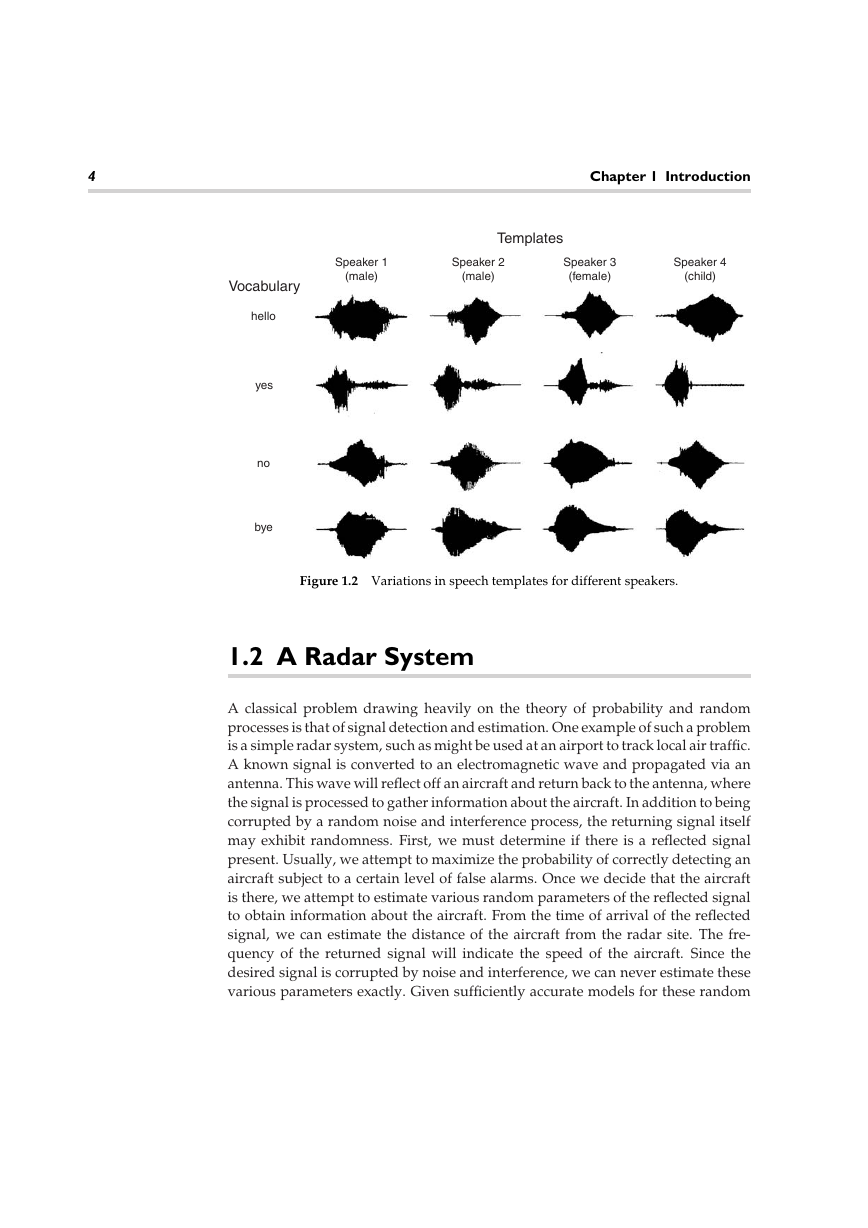
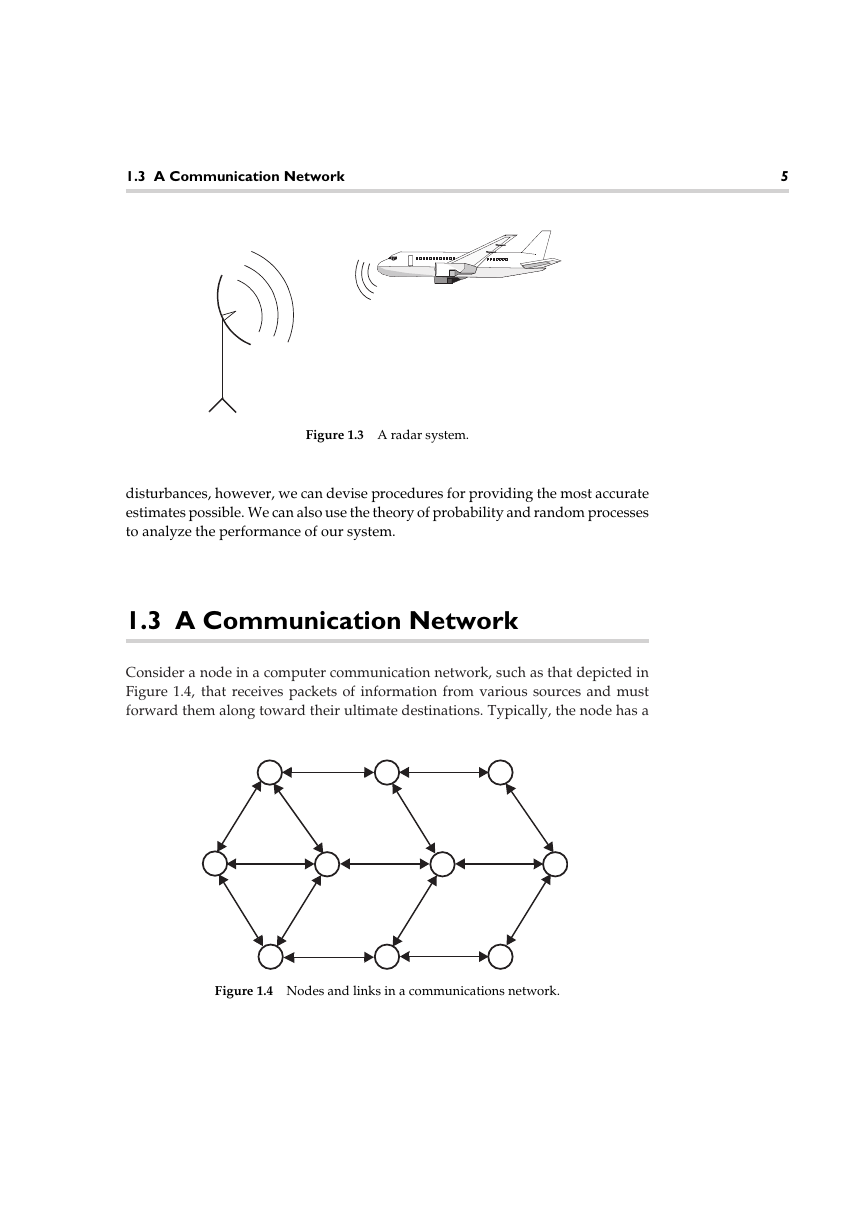








 2023年江西萍乡中考道德与法治真题及答案.doc
2023年江西萍乡中考道德与法治真题及答案.doc 2012年重庆南川中考生物真题及答案.doc
2012年重庆南川中考生物真题及答案.doc 2013年江西师范大学地理学综合及文艺理论基础考研真题.doc
2013年江西师范大学地理学综合及文艺理论基础考研真题.doc 2020年四川甘孜小升初语文真题及答案I卷.doc
2020年四川甘孜小升初语文真题及答案I卷.doc 2020年注册岩土工程师专业基础考试真题及答案.doc
2020年注册岩土工程师专业基础考试真题及答案.doc 2023-2024学年福建省厦门市九年级上学期数学月考试题及答案.doc
2023-2024学年福建省厦门市九年级上学期数学月考试题及答案.doc 2021-2022学年辽宁省沈阳市大东区九年级上学期语文期末试题及答案.doc
2021-2022学年辽宁省沈阳市大东区九年级上学期语文期末试题及答案.doc 2022-2023学年北京东城区初三第一学期物理期末试卷及答案.doc
2022-2023学年北京东城区初三第一学期物理期末试卷及答案.doc 2018上半年江西教师资格初中地理学科知识与教学能力真题及答案.doc
2018上半年江西教师资格初中地理学科知识与教学能力真题及答案.doc 2012年河北国家公务员申论考试真题及答案-省级.doc
2012年河北国家公务员申论考试真题及答案-省级.doc 2020-2021学年江苏省扬州市江都区邵樊片九年级上学期数学第一次质量检测试题及答案.doc
2020-2021学年江苏省扬州市江都区邵樊片九年级上学期数学第一次质量检测试题及答案.doc 2022下半年黑龙江教师资格证中学综合素质真题及答案.doc
2022下半年黑龙江教师资格证中学综合素质真题及答案.doc